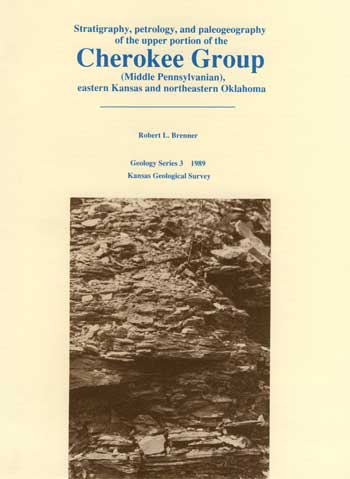Stratigraphy, petrology, and paleogeography of the upper portion of the Cherokee Group (Middle Pennsylvanian), eastern Kansas and northeastern Oklahoma
by Robert L. Brenner
University of Iowa

Originally published in 1989 as Kansas Geological Survey Geology Series 3. The publications is also available as an Acrobat PDF file (5.4 MB)
Executive summary
The upper portion of the Cherokee Group serves as host for petroleum-bearing sandstone and coal deposits that have contributed significantly to the economy of eastern Kansas and northeastern Oklahoma. Published studies of these rocks consist of regional studies based on outcrop observations and local studies based on subsurface data, usually centered upon a petroleum field. In this paper, I integrate surface and subsurface data that five graduate students and I collected and use this information to reconstruct the depositional and post-depositional (diagenetic) histories of these petroleum and coal-producing rocks.
This paper uses maps and cross sections to show the characteristics and distributions of rock types between two widespread black shale marker units. Sandstone bodies, which host most of the petroleum deposits of the upper portion of the Cherokee, form northeastward-trending "shoestrings" within lobate complexes that rim the margins of the Forest City basin and the Cherokee shelf. These complexes were formed by delta systems that prograded across the Pennsylvanian epeiric sea margin during times of low sea levels (i.e. eustatic regression). Coal beds represent swamps that covered major portions of delta plains and some interdeltaic areas. Overextending of delta-distributary channels resulted in channel diversion, the creation of new delta lobes, and the abandonment of previously active lobes. Marine environment covered abandoned lobes, burying swamp areas and channel sands with marine muds, thus protecting peat deposits and later serving as seals for underlying petroleum-bearing sandstones. During times of rising sea levels (i.e. eustatic transgressions), river mouths were shifted hundreds of kilometers northward and eastward, effectively cutting off the supplies of sand and mud to the sea that covered the study area. Depositional rates in the study area were extremely low during this time, resulting in very thin marine units that cover large portions of the area.
The locations of petroleum accumulations were determined by the distributions and characteristics of Pennsylvanian deltaic sedimentary complexes and the post-depositional (diagenetic) histories of the sandstone bodies within these complexes. Some diagenetic alterations destroyed the reservoir properties of sandstones by filling their void spaces (pores) with mineral cements. Other alterations enhanced these properties by dissolving previously deposited cements and, in some cases, portions of original sand grains. The distributions and intensities of diagenetic alterations seem to be controlled to a large extent by sandstone depositional environments and the sea-level changes that followed. Details of these and other possible mechanisms will be better understood as study of the petrology of Cherokee Group sandstones continues. Ultimately, depositional and diagenetic models will be developed that will be used to predict the locations and sizes of petroleum accumulations.
Abstract
The Desmoinesian Cherokee Group of eastern Kansas and adjacent states consists of cyclic sequences of mudrock, thin carbonates, and lenticular sandstones. This study focuses upon the upper portion of the Cherokee Group between two widespread black shale markers: 1) the Oakley shale which underlies the Ardmore limestone and 2) the Excello shale which overlies the Cherokee and forms the base of the Marmaton Group. The study area extends from the Nebraska-Kansas border south through the northern tier of counties in Oklahoma, and from the Kansas-Missouri border west to the Nemaha uplift.
Stratigraphic and sedimentologic interpretations were based on outcrops, well cores, and a grid of geophysical logs from over 1,200 wells. Petrologic interpretations were made primarily from thin sections of well-core specimens, augmented by outcrop specimens. This integrated approach allowed lithologic facies to be identified and mapped. It also helped to demonstrate that the stratigraphic-nomenclature schemes currently in use in eastern Kansas and northeastern Oklahoma are inadequate to describe the three-dimensional stratigraphy of the region. An informal stratigraphic scheme is used to avoid confusion.
Sedimentologic analysis using all available data shows that sandstones are concentrated as shoestring-shaped and thin sheetlike bodies within lobate sediment thicks. These thicks were deposited as deltaic complexes which included fluvial and distributary channel sands, interdistributary muds and marshes, crevasse-splay sands and muds, flood-basin muds and swamps, delta-front sands, and prodeltaic muds. These facies were deposited as delta lobes prograded across the margins of the Pennsylvanian epeiric sea during times of eustatic regression. When lobes were abandoned as distributary channels over-extended themselves, waves and currents reworked their upper portions, winnowing out muds and leaving thin sheetlike lenses of sand. These local transgressive units, lying above the regressive sequences formed by prograding delta lobes, form autocycles within eustatic regressive hemicycles.
During eustatic transgressions, shorelines were shifted northward and eastward very rapidly, moving siliciclastic point sources away from the study area. As a result, transgressing hemicycles are represented by diim reworked sandstone lenses, laterally extensive thin mudrock units, marine limestones, or black phosphatic shales.
Diagenetic alterations profoundly affected petroleum reservoir characteristics of Banzet sandstones. Thin marine sandstone units that were sampled are pervasively cemented, caused by an early stage of carbonate cementation. Some distributary-channel sandstone units have partial chlorite grain coatings, while other units that lack these coatings have well-developed quartz overgrowths that severely reduce both porosity and permeability. Fluvial and distributary-channel sandstones in northeastern Kansas seem to have undergone stages of late-carbonate cementation and concomitant silicate dissolution, followed by dissolution of carbonates. This sequence of events caused the development of significant volumes of secondary porosity, thus enhancing the reservoir characteristics of these sandstone units.
Kansas Geological Survey, Geology
Placed on web Oct. 27, 2010; originally published 1989.
Comments to webadmin@kgs.ku.edu
The URL for this page is http://www.kgs.ku.edu/Publications/Bulletins/GS3/index.html